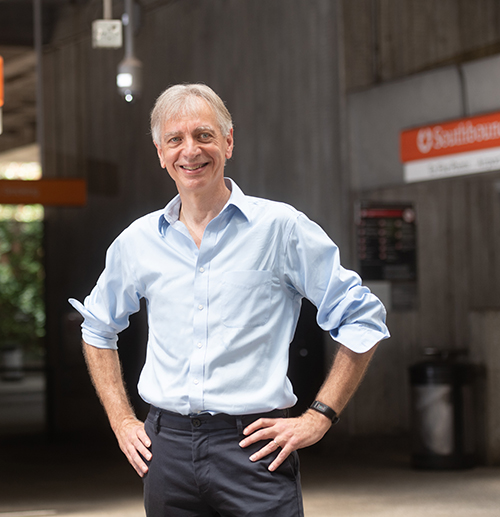According to the American Public Transportation Association, public transportation spurs economic development, promotes sustainable lifestyles, and provides a higher quality of life. It is also safer and less expensive than cars. However, most Americans still opt to drive personal vehicles rather than use public transit.
“In order to increase acceptance of public transportation, we need a system that gets people where they want to go in a more convenient and affordable way,” said Pascal Van Hentenryck, A. Russell Chandler III Chair and professor in the H. Milton Stewart School of Industrial and Systems Engineering (ISyE). “If we make public transportation more attractive to riders, it will decrease traffic congestion and greenhouse gas emissions and increase accessibility to jobs, health care, education, and food.”
Van Hentenryck has done significant research in the areas of artificial intelligence, data science, and operations research — all of which are essential to address the current problems in mobility. His goal is to create an equitable system that is both efficient for everyone and decreases reliability on personal vehicles.
Most public transportation systems in the U.S. have a significant first- and last-mile problem. “If you don’t pick people up within a quarter of a mile of where they live and drop them off very close to their final destination, you lose 90% of your ridership,” he explained.
In order to address this problem, Van Hentenryck suggests a multi-modal transportation solution in which small on-demand shuttles take passengers to and from high-frequency light rail and bus hubs, which will only be in high-density corridors. Shuttles will expand the reach of the system, so people are picked up much closer to their homes and dropped off at or near their destinations, making it significantly more convenient for riders.
In addition to addressing the first- and last-mile problem, the use of on-demand shuttles is also more cost effective and environmentally friendly. According to Van Hentenryck, most city buses are expensive to operate and drive with very few passengers on board. Replacing buses in low-demand routes with a greater number of smaller, inexpensive shuttles will increase efficiencies and lower overall costs. To further reduce greenhouse gas emissions, electric vehicles will be used whenever possible.
While the multi-modal approach may involve more transfers than the traditional model, the process will be simple and organized, allowing riders to reach their destinations in a similar amount of time to individuals driving personal vehicles. Each trip will require only one ticket, cost the same as traditional public transportation, and be completely synchronized to avoid long waits at the various transfer points. To facilitate this, Van Hentenryck and his team created algorithms that use machine learning and distributed optimization to predict ridership in real time, manage shuttle and passenger volume, and reduce wait times.
To date, Van Hentenryck has conducted successful case studies on the transit systems in the mid-sized cities of Canberra, Australia, and Ann Arbor, Michigan. In both cities, his multi-modal approach has shown a significant reduction in both cost and passenger wait times, and he hopes to apply the same strategies in Atlanta.
“Atlanta is one of the most congested cities in the world, but only about 3% of the population currently uses public transportation,” Van Hentenryck said. “There is a tremendous opportunity here if we can make public transportation easier and faster to use.”
In July 2019, Van Hentenryck and his team were awarded a $1.7 million National Science Foundation (NSF) grant to scale the optimization and machine-learning algorithms that were created in Ann Arbor and Canberra for a large city like Atlanta. The NSF Leap HI (Leading Engineering for America's Prosperity, Health, and Infrastructure) grant is in collaboration with civil engineering and urban planning, the Metropolitan Atlanta Rapid Transit Authority (MARTA), the Atlanta Regional Commission, and the City of Atlanta.
ISyE students — from undergraduates to post-docs — are also getting the chance to be a part of this exciting initiative. Van Hentenryck connected with MARTA shortly after joining the ISyE faculty in 2018, and he is leading an interdisciplinary Vertically Integrated Project team that is assisting with this initiative. In addition, in spring 2019 he advised two Senior Design teams that worked with MARTA to provide greater visibility into how patrons use the transit system — and one of the teams was a finalist for ISyE’s Best of Senior Design.
“The work that the students have done to date has been very useful,” said Rob Goodwin, MARTA’s director of research and analysis. “They are working with our data to give us a much more robust picture of how our patrons are using the system, which will allow us to see where there are opportunities and challenges in our system. We look forward to a continued relationship with Pascal and ISyE.”
Van Hentenryck and his team are eager to begin work on the grant and hope to have an impact on Atlanta traffic and accessibility. “Atlanta is a daunting challenge, which is why this project is so interesting,” Van Hentenryck noted. “We are looking at this bottom up, understanding mobility in the city and then step by step developing and integrating machine-learning and optimization algorithms for various novel mobility services that we will simulate at scale and hopefully pilot at some point.”
